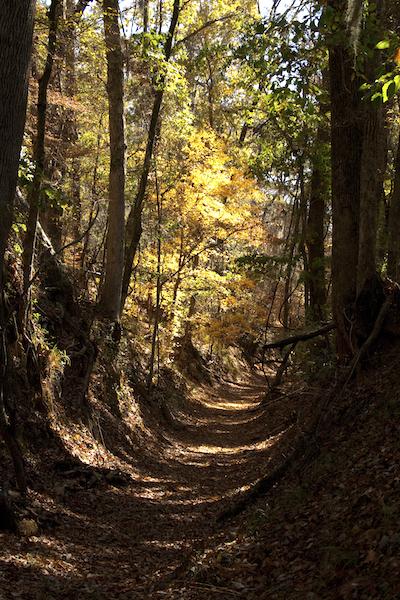While those push-button dashboard radios of the 1950s are now antiques, the American music of that era can still be found along the Natchez Trace Parkway. Starting in Nashville, Tennessee, then south to Natchez, Mississippi, take your wheels and cruise from Music City to Muscle Shoals, Alabama, for blues, then end up at the boyhood home of Elvis Presley in Tupelo, Mississippi.
The Natchez Trace is, literally, an All-American Road; rich in heritage, history, and culture. It ties together the heart of the American Music Triangle; a cross-section of three states where blues, jazz, Cajun, bluegrass, and even rock ‘n roll were born and are embedded in the countryside.
Nashville for instance, can satisfy most musical tastes, from country to rock, blues to gospel, jazz to bluegrass.
Of course, the 444-mile Trace is much more than music. It was one of the first land-routes in America, used for centuries by Native Americans, trappers, traders and frontiersmen. The Civil War left its mark here too, from Vicksburg, Shiloh, and Tupelo’s Brices Cross Roads national battlefields.

Whether by car, bicycle, or motorcycle, the Trace offers a relaxing fall vacation/Scenic Trace Compact
Much of the Trace, as you head north, passed through the Choctaw Nation before moving into Chickasaw lands. A small band of Choctaw Indians is still found at Choctaw, Mississippi, but the entire Chickasaw Nation was forced to move to Oklahoma in the 1830s. Later, they would become a key player, working to preserve lands and springs that today are part of the Chickasaw National Recreation Area.
From an architectural perspective, the Natchez Trace Parkway Bridge, which spans Birdsong Hollow near Nashville, is a 1,648-foot-long double arch structure that relies on its concrete arches to support the upper deck, without any supporting columns. The bridge is as picturesque as it is practical, and is surrounded by colorful woodlands.
Near Muscle Shoals you’ll explore one of the state’s finest collections of antebellum homes, in historic Tuscumbia. Visit Main Street and the brick building where Capt. Arthur Keller (Helen Keller’s father) edited a newspaper.
Some of these historic homes can also be seen in Natchez, including one owned by William Johnson. Johnson, an Africa-American businessman, recorded a diary describing everyday life, available at the museum.
At Kosciusko, Mississippi, you’ll see one of the oldest original settlements along the Trace. Named for a Polish general who aided the colonies during the American Revolution (a separate unit of the park system, the smallest of all, that is dedicated to the general can be found far north in Philadelphia). Today, this site is anchored by the historic downtown square where you’ll find antique shops, restaurants, and B&Bs.
The Parkway passes through many villages and towns, so there’s always a good reason to pull over and enjoy the maples, sweet gums, hickories and oaks that seem to set the countryside on fire with their vibrant displays.
Colorful dogwoods start to change along Tennessee stretches of the Parkway in early October, and mid-to-late October typically seems to bring the seasonal fireworks to their peak.

Pull off the road and you can walk in the path countless numbers of travelers have followed for centuries/NPS
“The best conditions to create fall color are when the autumn days are mild and sunny, and the evenings are cool and crisp, but not freezing,” notes the National Park Service, so keep an eye on the forecast as you plan your trip, and check the Natchez Trace Parkway website for weekly color updates.
Enjoy this seasonal show along the Old Trace Drive at Milepost 375.8, in Fall Hollow at Milepost 391.9, along the Natchez Trace National Scenic Trail from the Garrison Creek Trailhead at Milepost 427.6, and at the Little Mountain Overlook in the Jeff Busby Campground at Milepost 193.1.
There are lots of celebrations, fairs, and events along the Parkway during the fall months. Visit the Keg Springs Winery in Hampshire, Tennessee, which features “Music on the Deck” most weekends during September and October. The Amber Falls Winery nearby has live music as well.
The roots of American music are celebrated during “Dulcimer Days” at the Natchez Trace Parkway Visitor Center at Milepost 266. Here, on the first Saturday during September, October, November, and even December, from 10 a.m.-1 p.m., the North Mississippi Dulcimer Association provides a primer on the history of the Appalachian mountain dulcimer—the first instrument created in the United States—with concerts afterwards.
Birders will want to hike along the Parkway with their binoculars in northwestern Alabama, where Barred Owls and wild turkeys are common. Visit the Rock Springs Nature Trail north of Cherokee and watch for hundreds of migrating Ruby-throated hummingbirds, as they stop to rest among the orange jewelweed found on the edge of the wetlands.
If you’re passing through in late fall, look for bald eagles that winter near Waterloo, just west of the Parkway.
Once in Natchez, stop by the Natchez National Historical Park, managed by the National Park Service. With exhibits and displays you’ll learn that a French trading post was established here in 1714, that Spain gained control of the region in 1779, and finally that the United States took over in 1798.
Head north or south; it doesn’t really matter, and you’ll be rewarded along the Parkway as you slowly meander along at the posted 50 mph speed limit, which makes it that much easier to stop frequently and enjoy the landscape, history, and wildlife along the way.
For more information, visit the Scenic Trace Compact.



 Support Essential Coverage of Essential Places
Support Essential Coverage of Essential Places







Comments
It starts in Natchez dummy NOT Nashville,,, study just a little History,,, They came down the river and traveled UP the trace.
Remember to visit the Natchez Trace Wine Trail located off mile marker 391 of the Natchez Trace Parkway in Hampshire, TN. There are three wineries to visit and they are all located within just a few miles of each other. We would love to have you!